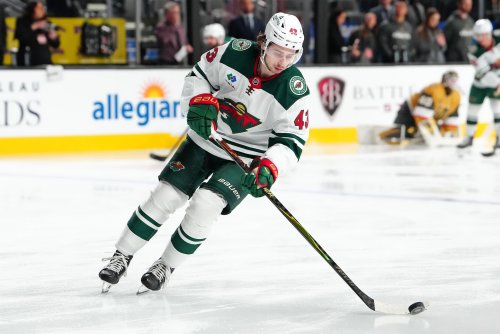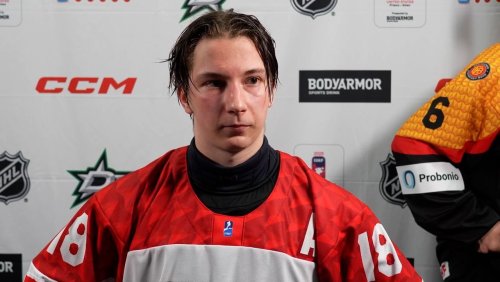.jpg.1b886a6d0d46dd11c091362234ef681c.jpg)
John Hynes is seeking to send a message with his “second effort” catchphrase.
Evidence is mounting that “second effort” was the theme of training camp. Hynes credited that for their 6-1 victory in the preseason finale. “The league is a second-effort league,” he explained. “That’s something we’ve emphasized in the style of practices.”
Before that post-game interview, Michael Russo reported in a recent podcast that second effort has been a theme in training camp, and he even used the “second effort league” phrasing. Russo believes that’s the reason for all of the battle drills in camp. Those drills are typically reserved for teams coming off a bad loss or young teams whose coach wants to set a tone. However, this is unusual for a veteran roster like Minnesota’s.
Missing last year’s playoffs was a huge disappointment, even if you blame it on injuries. The players will be more receptive to a culture shift coming off of that failure -- perhaps more receptive than they would be at any other time.
That puts the Wild at a crossroads this season.
It seems like you could say that about every team in any given year. However, owner Craig Leipold publicly stated that the Wild are focused on a championship in the next four seasons.
That mandate from the top should have the attention of every player on the roster.
The youth movement already taking shape on the team will further emphasize that. Liam Ohgren, Marat Khusnutdinov, and Jesper Wallstedt made the opening night roster, and defensemen Daemon Hunt and Zeev Buium could push for roster spots by the end of the year. Those players should push the older players to keep hold of their spots, and buying into Hynes’s messaging won’t be optional with that additional pressure.
Hynes couldn’t have picked a better time to set a team identity. It’s coaching genius.
Along with the great timing, this is a natural progression for a team whose franchise is synonymous with defense-first hockey. The same personal principles apply to “second effort” as they did under that structured identity of the past.
The Wild have taken pride in hard plays in the corners and at the net in the past. They don’t have to tear down the bones of an old culture to establish this new culture. Instead, Hynes can build off of what was already established.
So why the change?
Nobody can answer that question besides Hynes, and that’s probably not an answer he’d give publicly. NHL coaches generally keep this type of thing inside the walls of the locker room. However, to hazard a guess, it may have something to do with Minnesota’s lackluster offensive performance.
Last season, Minnesota ranked 23rd in five-on-five goals per minute. That wasn’t just a product of poor shooting, either. Their expected goals (xG) ranked 25th in the league. Expected goals is an analytical measure of all of a team’s chances. It’s intended to reward teams for generating more dangerous shots close to the net.
That could be the key to this new messaging: Take a team that takes pride in the dirty work and point that toward the other team’s net. “Second Effort” applies in all three zones, not just the defensive structure.
That’s also a great fit for the personnel on Hynes’s roster. The team’s leaders do their best work in front of the net, especially Joel Eriksson Ek and Marcus Foligno. Jared Spurgeon loves to use his lower body strength in those second-effort areas, such as the defensive zone corners and along the boards.
It also fits the scrappy playstyle of key role players like Ryan Hartman and Jake Middleton, players who need to have bounce-back years for the team to make the playoffs. New arrival Yakov Trenin is in the same mold. And, speaking of big years, Marco Rossi is primed for another leap after an intense offseason and a chance to center Kirill Kaprizov. Rossi may not be the first name that comes to mind, but he also has a way of getting to the offensive net-front.

Kirill Kaprizov will also back up all of this. Kaprizov’s leadership style was documented last year at The Athletic. Russo explained, “As Foligno has put it, Kaprizov has the skills of a superstar and the work ethic of a fourth-liner.”
Kaprizov tends to lead by example, and this second-effort identity is a natural fit for him. If Hynes hopes to nudge Kaprizov toward captaincy, it makes sense to build the team identity around their superstar’s playstyle.
This seems primed to work. Hynes has the players to make it work, and they should be a captive audience after last season’s disappointing ending. It fits what the team has done in the past, and it’s a great vision for their future.
If all this leads the Wild to better scoring, it’s a coaching success. If that happens after the offseason did very little to address the team’s middle-six scoring, it’s a master stroke.
Think you could write a story like this? Hockey Wilderness wants you to develop your voice, find an audience, and we'll pay you to do it. Just fill out this form.
-
 2
2






Recommended Comments
Join the conversation
You can post now and register later. If you have an account, sign in now to post with your account.
Note: Your post will require moderator approval before it will be visible.